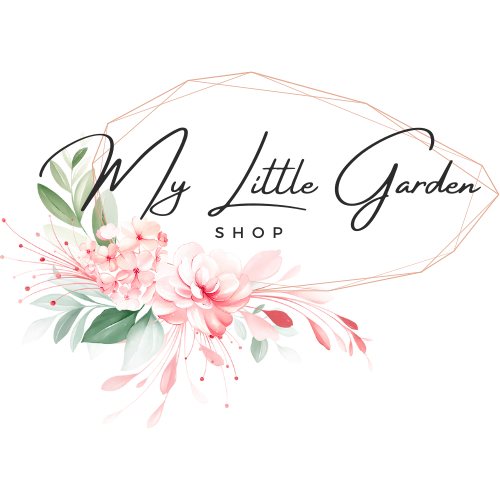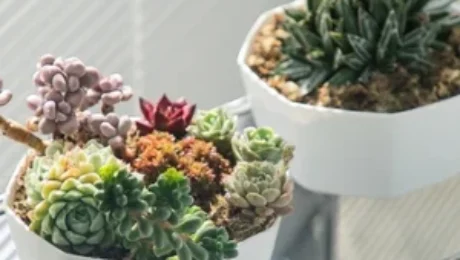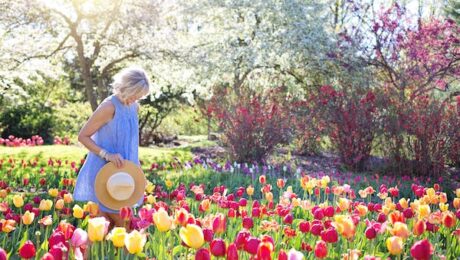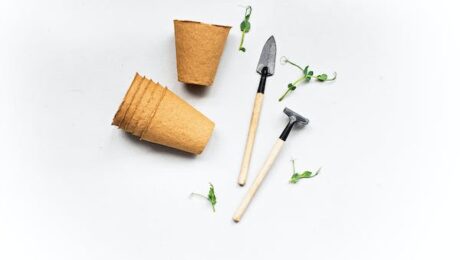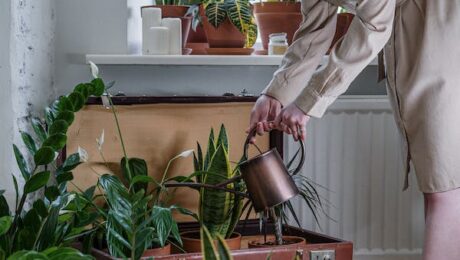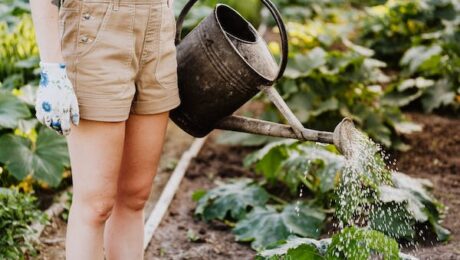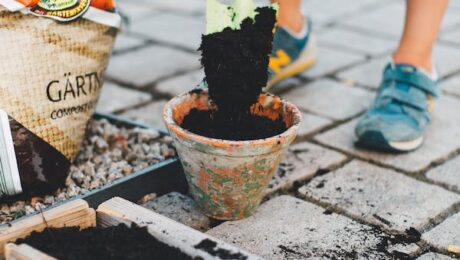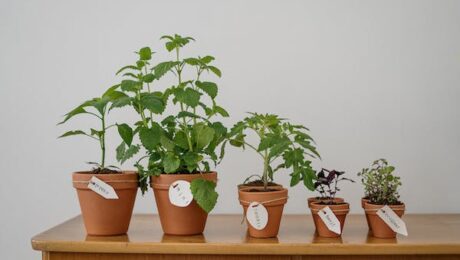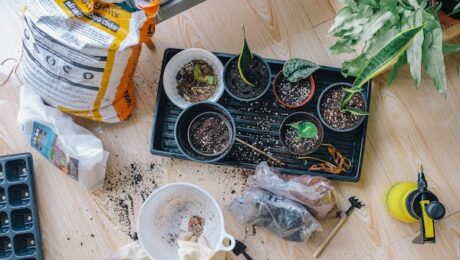A Beginner’s Guide to Succulent Care: Tips for Thriving Plants
I have just started to have an interest in growing succulents. Recently they have taken the world by storm with their unique beauty and easy-care requirements. These hardy plants are perfect for beginners and seasoned gardeners alike, adding a touch of green to any space. If you’re looking to add these trendy plants to your collection, I have found some essential care tips that may be very helpful.
1. Light:
Succulents love bright, indirect sunlight. Place them near a window where they can get plenty of natural light. Avoid placing them in direct sunlight for extended periods, as this can scorch their leaves.
2. Watering:
One of the most common mistakes in succulent care is overwatering. These plants are adapted to arid conditions and prefer infrequent watering. Allow the soil to dry out completely between waterings, and water deeply, ensuring that excess water drains out of the pot.
3. Soil:
Succulents need well-draining soil to prevent root rot. Use a specialized succulent or cactus mix, or amend regular potting soil with perlite or sand to improve drainage.
4. Temperature:
Succulents thrive in warm temperatures but can tolerate cooler conditions. Keep them away from drafts and extreme temperature fluctuations, especially during the winter months.
5. Humidity:
Low humidity is ideal for succulents. They do not require misting, and too much moisture in the air can lead to fungal issues.
6. Fertilization:
Feed your succulents with a diluted, balanced fertilizer during the growing season (spring and summer) to promote healthy growth. Avoid fertilizing in the winter when the plants are dormant.
7. Repotting:
Succulents generally do not need frequent repotting. Repot them when they outgrow their containers or if the soil becomes compacted. Use a pot only slightly larger than the current one to prevent overwatering.
8. Pests and Diseases:
Keep an eye out for common pests like mealybugs and spider mites, especially in indoor environments. Treat infestations promptly with insecticidal soap or neem oil. Ensure good air circulation around your plants to prevent fungal diseases.
9. Propagation:
Succulents are easy to propagate from cuttings or offsets. Simply remove a healthy leaf or stem cutting, allow it to callus for a few days, and then plant it in well-draining soil. Keep the soil lightly moist until roots develop.
10. Enjoying Your Succulents:
With proper care, your succulents will reward you with their unique beauty and resilience. Experiment with different varieties and arrangements to create stunning displays in your home or garden.
By following these simple care tips, you can ensure that your succulents thrive and bring joy for years to come. Happy planting!
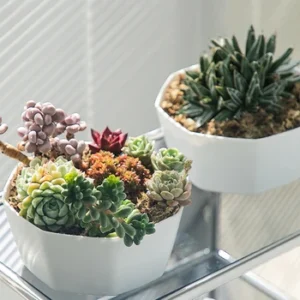
- Published in Uncategorized
A Year-Round Guide to Planting and Harvesting
There is something special about growing your own fruits, vegetables, and herbs. The satisfaction and joy of watching your plants grow, bloom, and produce a bountiful harvest is priceless. However, without proper planning and organization, gardening can often feel overwhelming and intimidating. That’s why we’ve created a seasonal gardening calendar to help guide you through the year, from seed starting to harvest time. With this calendar, you’ll have everything you need to stay on track and maximize the yield of your garden. Let’s get started!
Spring (March-May):
Spring is the season of renewal and regeneration, and it’s the perfect time to start planning your garden. Begin by sketching out your garden’s layout. This will help you visualize where everything will go and how much space you’ll need. Once you’ve figured out your garden’s layout, it’s time to start seed starting. Start your seeds indoors 6-8 weeks before the last frost date. Some seeds that are great to start in the spring are tomatoes, peppers, eggplant, and cucumbers. As the weather begins to warm up, it’s also time to plant cool-season crops like lettuce, spinach, and peas. Make sure to prep your soil beforehand by adding compost and organic matter to provide the necessary nutrients for your plants to thrive.
Summer (June-August):
Summer is the season of abundance, and your garden should reflect that. By now, your seedlings should have been transplanted into the ground, and your cool-season crops should be harvested. It’s time to plant warm-season crops like squash, beans, and corn. Make sure to keep your garden regularly watered and fed with fertilizer. You may also want to consider protecting your plants from the intense summer sun by providing shade or using a row cover.
Fall (September-November):
Fall is the season of harvest, and your garden should be in full swing. As the cooler weather approaches, it’s time to plant cool-season crops again like lettuce, kale, and arugula. It’s also time to start preparing your garden for winter. Remove any dead plants or debris, and mulch your soil to protect and nourish it during the colder months.
Winter (December-February):
Winter doesn’t have to be a time of dormancy for your garden. Depending on where you live, you can still plant winter crops like kale, spinach, and carrots. You may also want to consider planting cover crops like clover and vetch to enrich your soil and protect it from wind and erosion. Finally, take this time to reflect on the year and plan for next year’s garden. Consider what worked and what didn’t and start preparing for spring by ordering seeds and supplies.
Gardening is a rewarding and fulfilling hobby that doesn’t have to be overwhelming. With a bit of planning and organization, you can have a successful garden all year round. Remember to prep your soil, start your seeds on time, and consider planting seasonally appropriate crops. Take time to enjoy the beauty and bounty of your garden, and have fun experimenting with new plants and techniques. Happy gardening!
- Published in Uncategorized
Tips for Starting Your Edible Garden
Healthy eating begins with healthy choices, and what could be healthier than picking fresh, homegrown produce from your edible garden? Starting an edible garden is a fantastic way to embrace healthy eating habits, enjoy the outdoors and stay active, and save money on produce. No matter the size of your yard or balcony, anyone can create an edible garden with just a little bit of effort. In this post, we’ll tackle the basics of starting your own edible garden.
Planning
The first step towards a successful edible garden is planning. Start by choosing an ideal location where your plants can thrive. Consider sunlight exposure, soil quality, drainage, and accessibility. Once you’ve identified the perfect location, select the vegetables and herbs to grow. Consider the climate and weather conditions, seasonal changes, and the space available. You can start with a few small plants and then gradually add more as your garden grows over time.
Soil Preparation
The quality of the soil is critical for a thriving edible garden. Make sure you pick soil that is filled with organic matter, is nutrient-rich, and drains well. Add compost to the soil to provide your plants with the nutrients they need to grow healthy and strong. Use a shovel or rake to loosen the soil and remove any rocks.
Planting
When planting, place seedlings into the soil at a spacing distance that allows each plant enough space to grow. Make sure you plant them at the right depth according to the size of the seedlings and the soil type. Water the plants immediately after planting, providing them the right amount of water to keep them growing strong.
Watering, Weeding, and Fertilizing
Watering is important, so don’t let your plants dry out. In general, one to two inches of rainfall per week is ideal for most plants. Make sure you provide enough water to keep the soil moist, but not too wet. Weed your garden regularly, so the weeds don’t take over and steal soil nutrients. Fertilize the soil to keep the nutrient levels high, and your plants healthy throughout the growing season.
Harvesting
Harvesting your home-grown produce is one of the best moments of having an edible garden. Pick your vegetables and herbs when they’re ready, either young or at full size. For those that are not yet mature, let them linger on in the plant to allow them to mature fully.
Starting an edible garden is a gratifying journey that can add beauty and tasty treats to your life. With the right preparation and maintenance, you can easily create an edible paradise right outside of your house. Embrace the experience, and relish the healthy and delicious rewards of growing and harvesting your food. Get your green on!
- Published in Uncategorized
Your Guide to Must-Have Gardening Tools
Spring and summer just seem to be the perfect time to get into gardening, with all the sun and warmth inviting you outside, and the fresh air rejuvenating your spirits. If you are new to gardening or have been gardening for a while, here is a guide to must-have gardening tools that will help make your time in the garden more productive, enjoyable, and rewarding.
Good Quality Gloves – the first and essential item for every gardener would be a good pair of gloves. They will protect your hands from the harshness of the soil, thorns, and insects, as well as improve your grip while handling tools. Look for gloves made of breathable material, which will keep your hands dry and comfortable even on hot days.
Trowel – a trowel is a small handheld tool that is used to dig small holes, transplant seedlings, and remove weeds. A good trowel should be sturdy, with a comfortable handle, and a sharp edge. Look for one made of stainless steel, which will resist rust and last for years.
Pruning Shears – every gardener needs a pair of pruning shears to trim or shape plants, remove dead or damaged parts, or harvest herbs and vegetables. Look for shears with a bypass design, which will make clean cuts without crushing or tearing the stems or leaves. Also, opt for shears with a safety lock, which will prevent accidental cuts.
Watering Can – a watering can is a classic tool that is used to hydrate plants, especially those that are sensitive to overwatering or underwatering. Look for a can with a balanced handle and a long spout, which will allow you to pour water precisely where you need it. Also, choose a can with a removable rose or showerhead, which will provide a gentle and even flow of water.
Wheelbarrow – last but not least, a wheelbarrow is a versatile tool that is used to transport soil, mulch, compost, or plants around the garden. Look for a wheelbarrow with a sturdy frame, a deep and wide bin, and a comfortable handle. Also, opt for a wheelbarrow with pneumatic tires, which will roll smoothly over uneven terrain.
Gardening can be a wonderful hobby, providing you with fresh air, exercise, and food for your table. By equipping yourself with these must-have gardening tools, you will be able to work efficiently, safely, and joyfully in your garden, whether you have a small patio, a raised bed, or a sprawling estate. Don’t hesitate to invest in quality tools, which will save you time, money, and frustration in the long run. Happy gardening!
- Published in Uncategorized
The Rise of Indoor Gardening: A Thriving Trend
In this fast-paced era, it’s easy to feel disconnected from nature. With towering buildings and concrete structures dominating our surroundings, our need to reconnect with the earth has become more apparent. Fortunately, indoor gardening offers a solution as it has gained popularity in recent years. Cultivating plants indoors is not only a method of satisfying our desire to connect with nature, but it has also become a massive trend in urban living. In this blog post, we’ll discuss some of the reasons indoor gardening is on the rise and how it can benefit you.
Conquer the Challenges of Urban Living
Urban areas may lack the space and climate required for traditional outdoor gardening. Indoor gardening, however, provides a workaround to cultivate herb gardens, vegetable patches, and greenery without worrying about space limitations or drastic weather changes. Do you live in a high-rise apartment in a bustling city? No problem. Start a vertical garden or hang plants from the ceiling. It’s all about creativity and making the most of the space you do have.
Improved Air Quality
In addition to the aesthetic appeal, indoor plants can improve indoor air quality by removing pollutants and harmful toxins. More specifically, plants can absorb volatile organic compounds (VOCs) that come from everyday household items such as carpets, paints, and furniture. By keeping indoor plants around, you’re improving your quality of life in small, unseen ways.
Gardening as a Therapeutic Experience
Gardening also offers therapeutic benefits. Studies show that taking care of plants can reduce stress levels and anxiety, making it an ideal stress-reducing hobby. With a few minutes of care everyday, you’ll reap the rewards of watching your plants grow and thrive. It’s a perfect way to switch off and indulge in some positive energy.
Aesthetic Appeal
Indoor gardens come in various styles, shapes, and sizes, allowing them to fit in just about any room. From hanging terrariums to wall-mounted plants, there are many ways to add a touch of earthy decor to your living spaces. Displaying indoor plants also adds to the atmosphere by giving a refreshing and natural feeling, making any indoor space feel more relaxed, welcoming, and appealing.
Indoor gardening has become more than just a hobby; it has become a thriving trend that addresses the challenges of urban living. Not only does it provide the satisfaction of growing your food, herbs, and plants, but it also comes with ample benefits such as improving indoor air quality, generating therapeutic benefits, and enhancing the aesthetic appeal of your living spaces. Embracing indoor gardening, whether in a small studio or a modern bungalow, speaks volumes about the care and the responsibility taken for oneself to improve one’s wellbeing. So why not join the bandwagon of this fantastic trend and integrate your home with a lush and refreshing garden of your own?
- Published in Uncategorized
Watering Wisdom: The Key to a Thriving Garden
The world is a happier place when you are surrounded by lush greenery in your garden. However, maintaining a garden requires more than just planting a few seeds and ignoring them. One of the most fundamental and essential components of ensuring healthy plants is by providing sufficient water. Yet, it’s baffling how many gardeners struggle with this. Successfully watering your plants is as much an art as it is a science. Mastering the right balance of water is critical if you want your plants to thrive. In this blog post, we will uncover some watering wisdom and explore the secrets to a flourishing garden that will leave you feeling like the gardening guru you deserve to be!
Knowing Your Plants
When it comes to watering, one size does not fit all. Different plants have varying water needs, depending on their species, maturity level, soil type, and weather conditions. Overwatering can lead to root rot, disease, and even death. On the other hand, underwatering can stunt growth, prevent nutrient absorption, and leave your plants parched beyond recovery. Knowing your plants’ water requirements and establishing a regular watering routine will keep them healthy.
Consider Using a Drip Irrigation System
A drip irrigation system is an excellent investment for a garden. It’s a process of supplying water directly to the plant’s roots in small, continuous, and measured doses. This system delivers water precisely where the plant needs it, minimizing water waste and reducing the risk of root disease. Drip irrigation also allows you to water plants precisely without getting water on the leaves, which can promote fungal growth. A drip irrigation system is perfect for a busy gardening schedule, allowing you to set a timer and let the watering take care of itself!
Use Soaker Hoses
A soaker hose is another option that distributes water to your plants’ roots quickly and evenly without excess runoff. These hoses work by leaking water slowly, ensuring a consistent supply to the roots, and avoiding over-saturating the soil and stress on your plants. They’re an eco-friendly way to conserve water.
Timing is Everything!
Timing is critical when it comes to watering your garden. Early morning is the best time to water since temperatures are cooler, and the water can evaporate less in the heat of the sun. Try to avoid watering during the heat of the day, as most plants will lose water quickly through transpiration, making it harder for them to retain moisture. Also, avoid watering at night, which can lead to prolonged wetness, encouraging fungal growth.
Observe Your Plants Regularly
The final piece of watering wisdom includes observing your plants. By keeping a close eye on your plants regularly, you can detect when there are changes that may indicate they need more or less water. This tactic will vary during different times of the year and will depend on the weather, sunlight, and humidity levels. If your plants are showing signs of drooping leaves, then it’s time to give them some water. After some regular watering, if there is no improvement, then there may be a more serious issue. Overwatering and underwatering can have similar results, so observe your plants carefully, and actions can be taken accordingly.
In conclusion, watering your garden correctly is a vital aspect of gardening that cannot be overlooked. It’s essential to understand your plants’ watering needs and supply them with the right balance of water to prevent overwatering and underwatering conditions. Consider investing in a drip irrigation system or soaker hoses to maintain a consistent supply of water. Timing is also important, and early morning watering is the best time to water. Remember to observe your plants regularly for any changes that need intervention and respond accordingly. With this watering wisdom, you can turn your garden into a flourishing paradise with thriving and healthy plants!
- Published in Uncategorized
Get Your Hands Dirty: Tips for Soil Preparation and Fertilization
Want to have a thriving garden? Healthy soil is the key! Soil preparation and fertilization play a crucial role in the growth of your plants. By taking the time to properly prepare your soil and providing the right nutrients, you can have beautiful and healthy plants that will flourish for years to come. In this blog post, we’ll provide you with some useful tips and tricks on how to get started with soil preparation and fertilization.
Soil Preparation:
The first step in soil preparation is to remove any debris, such as rocks, twigs, or leaves, from the soil. This will ensure that the soil is free of any obstructions that could prevent your plants from growing deep roots. The next step is to aerate the soil. Aeration involves creating small holes in the soil, allowing air, water, and nutrients to penetrate deeper into the soil. You can use a garden fork to aerate the soil manually or rent an aerator machine from your local garden center. Finally, you should add organic matter to the soil. Compost, grass clippings, and leaves are excellent sources of organic matter that can be added to the soil to increase fertility and improve soil structure.
Fertilization:
Different plants require different nutrients to grow properly. Nitrogen, phosphorus, and potassium are the three main nutrients that plants need, but each plant has different requirements for each nutrient. Before fertilizing your plants, you should determine what nutrients your plants need. You can do this by testing the soil or by researching the specific needs of the plants you’re growing. Organic fertilizers, such as compost, manure, and bone meal, are great options for those who want to avoid using chemical fertilizers. However, if you prefer chemical fertilizers, be sure to follow the instructions carefully, as too much can be harmful to your plants and the environment.
Timing:
The timing of fertilization is just as important as the type of fertilizer you use. Different plants require different timing for fertilization, so it’s important to research the specific needs for the plants you’re growing. Generally, it’s best to fertilize your plants in the spring and early summer, as this is when they are actively growing. Avoid fertilizing your plants in the fall, as this can cause new growth that may be damaged by winter weather.
Composting:
Composting is a great way to enhance soil fertility, reduce waste, and save money on fertilizers. Compost is a natural fertilizer that enriches the soil with nutrients and microorganisms. To start composting, you need a compost bin or pile, yard waste, and kitchen scraps. Proper composting involves layering brown materials, such as leaves and paper, with green materials, such as kitchen scraps and grass clippings. You can also add garden soil or compost starter to speed up the composting process. Once the compost is ready, you can mix it into the soil or use it as a top dressing for plants.
Natural Fertilizers:
If you want to avoid using chemical fertilizers, there are several great options for natural fertilizers. Animal manure, bone meal, blood meal, and fish emulsion are all excellent sources of nutrients that can be added to the soil. However, it’s important to use natural fertilizers in moderation, as too much can be harmful to your plants and the environment. Additionally, you should always research the specific needs of the plants you’re growing before adding any type of fertilizer to the soil.
Preparing the soil and fertilizing your plants may seem like hard work, but the end result is worth it. By investing time and effort into soil preparation and fertilization, you can enjoy beautiful and healthy plants that will thrive for years to come. Remember to remove debris, aerate the soil, and add organic matter for soil preparation. Test the soil or research the specific needs of your plants for fertilization. Be sure to follow instructions on fertilizers and use them at the appropriate time. Composting is a great way to enhance soil fertility naturally. Finally, natural fertilizers can be a great alternative to chemical fertilizers but always use them in moderation. Happy gardening!
- Published in Uncategorized
The Ultimate Guide to Selecting the Right Plants for Your Garden
Gardening is a beautiful hobby that brings so much joy to our lives. It allows us to connect with nature, get our hands dirty, and create a stunning outdoor oasis. But if you’re new to gardening, or if you’ve had a few flops in the past, it can be overwhelming to know where to start. The key to a flourishing garden is selecting the right plants for your specific conditions. In this ultimate guide, we’ll take you through all the steps you need to take to choose the perfect plants for your garden.
Step 1: Assess Your Space
The first step in selecting the right plants is to assess your garden space. Is it sunny or shady? Does it have well-draining soil or is it heavy clay? Are there any areas that are consistently moist or dry? Taking stock of your garden’s conditions will help you narrow down the types of plants that will be happy and thrive in your garden.
Step 2: Determine Your Zone
Your zone is determined by your location and the USDA Plant Hardiness Zone Map. This map divides the United States into 13 zones based on average annual minimum temperatures. Understanding your zone will help you select plants that will be hardy enough to survive winters and summer heat waves.
Step 3: Research
Once you know your zone and garden conditions, it’s time to research potential plants. Look for plants that are well-suited to your zone, and that will thrive in the conditions of your garden. Consider the plant’s growth habit, size, and maintenance needs. Research will help you determine which plants are likely to be successful in your garden, saving you time and money.
Step 4: Visit Your Local Nursery
Your local nursery is an excellent resource for selecting the right plants for your garden. Go there with a list of potential plant candidates, and ask for the advice of the staff. They’re knowledgeable about the local climate, and can help guide you toward successful plant choices. Plus, many nurseries have a return policy, so if a plant doesn’t succeed in your garden, you can return it and try again.
Step 5: Plan Your Garden Design
After you’ve selected your plants, it’s time to plan their layout in your garden. Keep in mind the plant’s mature size, shape, and form when deciding where to place them. Plants that thrive in similar conditions can be grouped together, making maintenance easier and minimizing water runoff.
By following these five simple steps, you’ll be able to select the right plants for your garden with confidence. Remember, a successful garden begins with careful planning and plant selection. Take your time, do your research, and enjoy the process of creating a beautiful outdoor space that will bring joy for years to come. Happy gardening!
- Published in Uncategorized
Finding Your Perfect Garden Space
Welcome to the wonderful world of gardening! Whether you’re an experienced green thumb or a total newbie, the first step to creating a successful garden is choosing the right location. With so many options available – backyard, balcony, windowsill, community garden – it can feel overwhelming. But don’t worry, we’re here to help guide you through the process. In this post, we’ll explore different factors to consider when selecting your garden space, ensuring that you create a space where your plants will thrive.
When choosing your garden space, one of the most important things to consider is sunlight. All plants require sunlight to grow, but some need more than others. Look for a spot that receives at least six hours of direct sunlight a day, preferably in the morning. South-facing areas are generally ideal for sun-loving plants, while north-facing areas may be better suited for shade-loving plants. Balconies or windowsills may be tricky if they don’t get direct sunlight, but a grow light can be a great solution to supplementing the natural light.
Soil quality is another critical factor in garden success. If you’re working with soil outdoors, take a look at the ground’s color and texture. Soil should look and feel loose and crumbly. If it’s too hard or clay-like, it may be challenging for plant roots to penetrate. Adding amendments such as compost or peat moss can help to improve the soil’s structure and nutrient content. If you’re working with a container garden, choose high-quality potting soil designed for your plants’ needs.
Equally important is the available garden space. Think about the number of plants you want to grow and how much room they’ll need to spread out. Depending on how much space you have, you may need to get creative with vertical gardening or trellising to maximize your growing capacity. Don’t forget to factor in other elements of your garden space, such as walkways or seating areas – you’ll want to make sure you leave enough room to comfortably access your plants.
Other considerations making the best of your garden space include proximity to water, drainage, and privacy. You’ll want to choose a location close to a water source, or if that’s not possible, have an efficient watering system in place. Proper drainage is important to prevent waterlogged soil, which can lead to root rot. And if you’re living in a communal space, think about privacy measures such as trellising or landscaping to create a sense of seclusion while still enjoying the benefits of your garden.
Taking the time to assess your available space may seem daunting, but it’s essential to ensure the success of your garden. By considering elements such as sunlight, soil quality, available space, proximity to water, drainage, and privacy, you’ll be on your way to creating a thriving garden space. And with just a little bit of planning, you’ll be rewarded with the beauty and bounty of your garden for years to come. Happy planting!
- Published in Uncategorized
